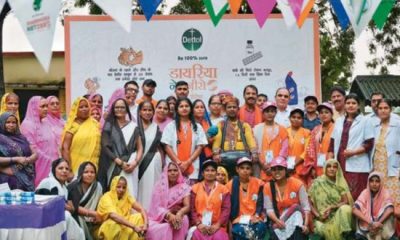Highlights
- Persons preparing the corpse for last rites must wear protective gears: WHO
- WHO warns families and friends against touching or kissing the body
- To open a body bag or coffin for viewing, use gloves and medical mask: WHO
New Delhi: COVID-19 has tested every aspect of human life in the last few months. The fear of contracting the virus and then spreading it has been a cause of widespread anxiousness. Once infected the separation from loved ones and the uncertainty can weaken even the most spirited. And for the less fortunate even in death the pandemic has been a traumatic experience for near and dear ones. The restrictions in place to control the transmission of the novel coronavirus meant that not many could pay their last respects or be there for the last rites of the departed. But now a new interim guideline for infection prevention and safe management of dead bodies in the context of COVID-19, released by the World Health Organisation (WHO) on September 4 says that families can hold funerals and bodies can be buried or cremated according to family preferences.
Also Read: Sero-Survey Conducted In August Finds No Antibodies In 30 Per Cent Of Recovered COVID-19 Patient
The last rites have been shortened and limited to a minimum number of people in close contact with the departed person because of the pandemic. The new guideline of WHO says the family and friends of the patient who succumbed to the disease should follow local guidance regarding the number of people that can attend a funeral/ viewing or burial in community setting, including the home. The interim guidelines released by WHO on March 24 for dead body management during COVID, however, did not talk mention about families and friends holding funerals for their loved ones who died due to COVID-19. Both old and new guidelines recommend that funeral ceremonies that do not involve the disposal of the body should be postponed. WHO said in its guidelines,
Although burials or cremations should take place in a timely manner and in accordance with local practices, funeral ceremonies that do not involve the disposal of the body should be postponed, if possible, until the end of the epidemic. If a ceremony is held, the number of participants should be kept to a minimum. Participants should observe physical distancing, respiratory etiquette, local mask wearing requirements, and hand hygiene at all times.
The guidelines also say that the number of people performing autopsies, involved in preparing the body and those conducting the burial must also be kept at minimum and they must wear appropriate protective gears to protect themselves from any potential infections.
The WHO has, also warned funeral services, organizations and mortuary services facilities against embalming COVID-19 bodies as it involves excessive manipulation of that body that may expel air and fluids from the lungs. Embalming is the process of preserving the cadaver by treating it with chemicals and removing body fluids in order to prevent decay. WHO says in its guidelines,
Based on current knowledge of the symptoms of COVID-19 and its main modes of transmission (droplet/contact), the likelihood of transmission when handling human remains is low
Explaining about the low risk of infection from the dead body of COVID-19 patient, Dr. Ramana Dhara, Professor at Indian Institute of Public Health (IIPH), Hyderabad said that unlike fevers like Ebola, Marburg, and diarrheal diseases like cholera that are Hemorrhagic or cause blood or body fluid to escape from a raptured blood vessel or organ, death from respiratory illnesses like COVID-19 do not pose any risks unless the person handling the dead body comes into contact with body secretions of some form. He further said,
Even though a person suffering from COVID-19 may have died and be no longer as infective, however, the lungs and other organs may still contain live viruses. Appropriate protective gears must be worn while handling the body and measure must be taken toward avoiding contact with the fluids.
The guidelines further added that mortuary staff or funeral home workers or any family member or religious leader preparing the body by performing certain processes including washing the body, tidying/shaving hair, or trimming nails should wear appropriate personal protective equipment (PPE) including gloves, impermeable gown or gown with an impermeable apron, medical mask, eye protection (face shield or goggles) and closed footwear or footwear protection.
The guidelines say that family and friends can view the body but they must be instructed to not touch or kiss the body in families where it is the part of funeral procedures and maintain at least one metre distance from one another and perform hand hygiene after viewing.
To open a body bag or coffin for viewing, use gloves and medical mask, and once the body bag or coffin is opened, remove gloves and perform hand hygiene, said the guidelines.
WHO has emphasised on respecting the dignity of the dead, their cultural and religious traditions. It has called for respect and protection to the families of the departed patients throughout the burial/cremation ceremony and has said that hasty disposal of the person who died of COVID-19 must be avoided. The belongings of the dead person do not need to be burned or otherwise disposed of. However, WHO recommends that the belongings should be handled while wearing gloves and cleaned.
It says that mourners who are above 60 years of age or with underlying conditions like hypertension, diabetes, among others must take necessary precautions like wearing a medical mask in order to carry out safe last rites. It suggests that people who are unwell should not participate in the viewing or funeral.
According to Dr. Dhara, health authorities of various countries across the globe have released their own set of guidelines regarding dead body management of COVID-19 positive patients that are mostly similar to WHO’s guidelines with some variations. In India, the current guidelines that are in place were released on March 15 by the Ministry of Health and Family Welfare. The Centre’s guidelines allow viewing of the dead body by unzipping the face end of the body bag (by the staff using standard precautions) if the relatives wish to see the body for the one last time. It does not allow bathing the dead body, kissing or hugging it and calls for practising hand hygiene after cremation/burial of the body. It prohibits large gatherings at the crematorium and says that social distancing should be maintained. The guidelines issued by the Centre states,
The main driver of transmission of COVID-19 is through droplets. There is unlikely to be an increased risk of COVID-19 infection from a dead body to health workers or family members who follow standard precautions while handling the body.
While there are no new updates in the guideline or standard operating procedure (SOP) incorporating changes added in WHO’s guidelines, an official at the MoHFW said that the states can release their own SOPs on the basis of Centre’s and WHO’s guidelines. For example, in Rajasthan, the bodies of patients who have died or suspected to have died of COVID-19 will be handed over to the family for cremation who must cremate the same following the safety measures mentioned in the guidelines. State Health Minister Dr. Raghu Sharma said on September 9 in a press statement,
The government apart from being alert and cautious is also sensitive. Knowing the intention of the general public, the Chief Minister has directed the department to hand over the dead body of COVID infected patient to the family members and get the cremation done by taking full caution. There should not be more than 20 people during the cremation. During the cremation, it will be necessary to wear PPE kit, gloves, mask, maintaining social distance along with to fully comply with all the other protocols. No permission from anybody is required to take a body from one district to another.
Dr. Sharma added that the protocol has been added to enable people catch a glimpse of the COVID patient for one last time. He said that touching, hugging, kissing the dead body would be prohibited.
According to the Ministry of Health and Family Welfare (MoHFW), as of now, there have been over 82,000 COVID-19 deaths in the country. Globally, as of Wednesday (September 16), more than 9.34 lakh people have succumbed to COVID-19 over the past nine months.
Also Read: Top Doctors Urge People To Strictly Follow COVID-19 Safety Protocol
NDTV – Dettol Banega Swasth India campaign is an extension of the five-year-old Banega Swachh India initiative helmed by Campaign Ambassador Amitabh Bachchan. It aims to spread awareness about critical health issues facing the country. In wake of the current COVID-19 pandemic, the need for WASH (Water, Sanitation and Hygiene) is reaffirmed as handwashing is one of the ways to prevent Coronavirus infection and other diseases. The campaign highlights the importance of nutrition and healthcare for women and children to prevent maternal and child mortality, fight malnutrition, stunting, wasting, anaemia and disease prevention through vaccines. Importance of programmes like Public Distribution System (PDS), Mid-day Meal Scheme, POSHAN Abhiyan and the role of Aganwadis and ASHA workers are also covered. Only a Swachh or clean India where toilets are used and open defecation free (ODF) status achieved as part of the Swachh Bharat Abhiyan launched by Prime Minister Narendra Modi in 2014, can eradicate diseases like diahorrea and become a Swasth or healthy India. The campaign will continue to cover issues like air pollution, waste management, plastic ban, manual scavenging and sanitation workers and menstrual hygiene.
[corona_data_new]



















